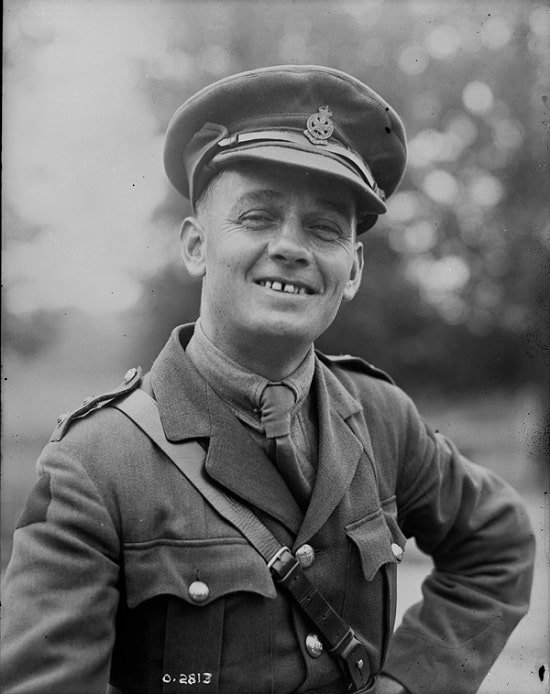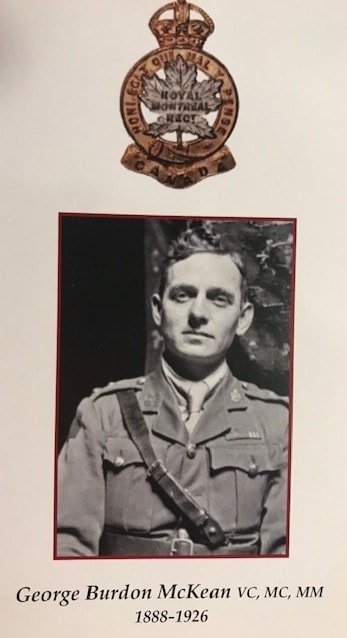This is the story of Captain George Burdon McKean, three times rejected, three times a hero.
We are grateful to Peter Beale for sharing his amazing family story about Captain George Burdon McKean, VC, MC, MM. He could rightly be hailed a hero and in fact has been so recognised. However, his amazing life followed feelings of rejection, three times.
The discovery of his life commenced after Peters wife’s mother, Mrs Enid Makinson was invited to the unveiling of a memorial to him. It became apparent that George was her Great Uncle. She was part of the family from Willington, Co. Durham as was therefore invited to the unveiling of the memorial to him.
George was born in Willington on 4th of July 1888 to James & Jane Ann McKean. He was described as an extremely delicate baby. His father was a furniture dealer who died when he was still young. He then moved to Bishop Auckland with his mother & sister.
He attended Bishop Barrington School, leaving at the tender age of 13 years. He became an apprentice cabinet maker to T. Thompson, in Newgate Street Bishop Auckland.
His mother died in September 1902 when he was just 14 years old. After this he sailed from Liverpool to Montreal on the SS Tunisia to join his brother on a cattle ranch in Edmonton Canada. He later attended Alberta University studying arts when the 1st World War broke out.
He applied to join the Canadian Expeditionary Force but was turned down 3 times on the grounds of poor physique. His personal details read; age -26 years 6 months height 5ft 6ins Girth 37 in expansion 2inch, complexion natural, dark blue eyes dark brown hair & Presbyterian?
Then fourth time lucky, on the 23rd January 1915, he enlisted with the 14th Infantry Battalion the Royal Montreal Regiment. After completing basic training, 436568 Private McKean arrived back in Britain on April 1916. He then found himself on the Western Front in June 1916.
He was subsequently promoted to Corporal. On the night of 1st/2nd March 1917 near Colonne, he was a patrol leader probably because of his small physique, the citation reads as follows:-
Military Medal
“As patrol leader he made continuous reconnaissance’s of the enemy’s positions & wire prior to the raid on the enemy’s trenches on the night of 1st/2nd March 1917 near Colonne.
The information proved most accurate & was obtained at great personal risk. This NCO was recommended for gallantry during the operations on the Somme.”
For this action he received the Military Medal. He was also promoted to Lieutenant which was a fantastic achievement of its own.
More was to come on the 27/28th April 1918 when his battalion was near Gavrelle. Lt McKean was leading a party of scouts against a German trench that was being staunchly defended, his men then hesitated. The citation reads:-
Victoria Cross
“For most conspicuous bravery & devotion to duty during a raid on the enemy’s trenches. Lieutenant McKean’s party, which was operating on the right flank, was held up at a block in the communication trench by most intense fire from hand grenades & machine guns. This block which was too close to our trenches to have been engaged by preliminary bombardment, was well protected by wire & covered by a well-protected machine gun thirty yards behind it.
Realising that if this block was not destroyed, the success of the whole operation might be marred. He ran into the open on the right flank of the block, & with utter disregard of danger leaped over the block head first on top of the enemy. Whilst lying on top of one of the enemy another rushed at him with fixed bayonet. Lt McKean shot him through the body & then shot the enemy underneath him who was struggling violently. This very gallant action enabled this position to be captured. Lt McKean’s supply of bombs ran out at this time & sent back to our front line for a fresh supply. Whilst waiting for them he engaged the enemy single handed. When the bombs arrived he fearlessly rushed the second block killing 2 enemy & capturing 4 others & drove the remaining garrison including a hostile machine gun section into a dug out. The dug out with it’s occupants & machine gun was destroyed. This officers splendid bravery & dash undoubtedly saved many lives, for had not this position been captured the whole of the raiding party would have been exposed to dangerous enfilading fire during the withdrawal. His leadership at all times has been beyond praise.”
You would have thought that’s it, keep your head down; but no. At a village called Cagincourt in September 1918, he found himself along with 3 other Canadians, several minutes ahead of their troop. With great bravado he began waving his arms and guns, whilst bellowing out orders.
Military Cross citation reads;
“For conspicuous gallantry & devotion to duty during an attack near Cagincourt on September 1st/2nd 1918. As scout officer during two days of heavy fighting he with his scouts led the battalion forward & sent in accurate reports & rallied men who had lost their officers. He was early wounded but pressed forward & entered Cagincourt with three men and observing a party of enemy over a hundred strong retiring from the village, he dashed to the flank, heading them off and caused them all to surrender. Had these enemy troops been allowed to take the high ground east of the village, they would have inflicted heavy casualties on our troops. He continued to send in reports until exhausted by loss of blood. His conduct throughout was magnificent.”
This action was reported to honour him with a VC Bar but for some reason he got the MC.
He left the army in July 1919 with the rank of Captain. He married Constance Hilton in Brighton and was employed running a saw mill in Hertfordshire. It was in November 1926, aged just 38 tragedy struck. The local newspaper reported; Captain McKean was sawing logs at his mill in Cuffley when the blade broke and his head came into contact with the revolving saw. Terrible injuries were inflicted and he died a few days later. The tragedy was compounded when two days later his wife gave birth to their daughter Patricia.
The Canadians felt they had lost one of their Great War heroes and named a 9,000ft mountain in the Jasper National Park, Rocky Mountains, Mount McKean. He is also remembered in Cagincourt, where after it being rebuilt following the war, the church square was named La Place du George Burdon McKean. His name is also present in a Memorial wall in the University of Alberta where he had studied before the war.
Such a sad end to a distinguished life and military service. His name is still revered amongst Canadian Military circles. He is buried in Brighton Cemetery.
Reflecting on his story, we may wonder if those times of rejection felt by George were in fact the inspiration he required for those deeds of gallantry which he showed that ultimately saved the lives of so many. Three times he was rejected only to become three times a hero.
Mount McKean is located in the Victoria Cross Mountain Range in the Jasper National Park, Alberta, Canada.



